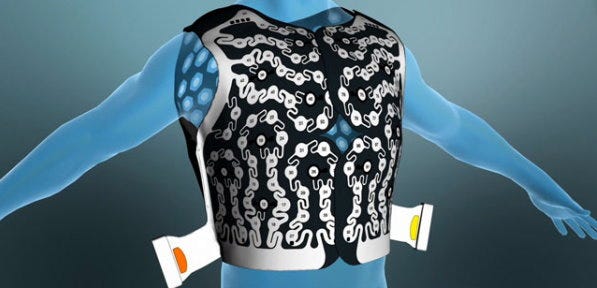October 23, 2015
Decades ago, a Case Western Reserve University professor had the idea for a more-precise alternative to the EKG. The technology formed the basis for the company CardioInsight, which was acquired by Medtronic earlier this year.
Brian Buntz
|
The CardioInsight ECVUE vest has sensors integrated through, probing the heart through a patient's chest and back. |
While working a Case Western Reserve University, Yoram Rudy, PhD had the idea for a game-changing cardiac monitoring device--a vest filled with more than 200 sensors that could detect the heart's electrical activity. While standard 12-lead EKGs had become the gold standard for detecting many heart problems, EKGs still can miss cardiac problems because they only probe electrical potential at a limited number of points on the body.
In 2004, when Rudy's technology was featured in The New York Times, he had been working on refining the idea for 20 years. At that point, the technology was able to noninvasively detect sites initiation sites of arrhythmic activity in the heart--an unprecedented breakthrough that would ultimately attract the attention of Medtronic roughly a decade later. Rudy's students would ultimately continue refining the technology and ultimately founded the firm CardioInsight to commercialize it, which was acquired this year for $93 million.
Before that though, the technology was a rough prototype. CardioInsight partnered with product development firm Nottingham Spirk (Cleveland, OH) to transform a "Frankenstein prototype" strewn with wires weighing about 15 pounds into a sleek device weighing a few ounces, explains John Nottingham, co-president and co-founder, of the Nottingham Spirk.
Upon first seeing the prototype, Jeff Taggart, program director, engineering team at the design firm remembers thinking: "that's a mess!" He continues: "But, being from the technical field, I understood what the prototype was all about and that it did exactly what it needed to do, it just need to be taken to the next level."
While the idea behind the technology was brilliant--putting 252 EKG-type sensors on the body to gather electrical signals from the body and convert them into a graphic model of the heart, translating that idea into a sleek device was an immense challenge. "You can imagine having a patient and physically putting 252 sensors on them one by one," Nottingham says.
"There is another component that was very important," Nottingham adds. "When they teach you how to apply electrodes for an EKG, there is particular spacing you have to follow based on the anatomy." Because there is wide variability in size and shapes between people, the designers of the CardioInsights device had to accommodate for that in the vest to optimize the placement of all the sensors on the body.
The design firm was able to help optimize the sensor placement by studying biomimicry. "Over 13.8 billion of years, nature has solved pretty much every problem," Nottingham says. "When it comes to sensors varying to accommodate different body shapes, we looked at how nature handles scale and that gave us a clue on how to be flexible with the design."
Another complication was that the company was given an aggressive price target and had to optimize the design of the device so that it could ultimately be reimbursable.
The design firm ultimately came up with a disposable product, achieving much of the weight reduction thanks to printed electronics.
"When we were designing it, we were working directly with a flex circuit manufacturer getting the drawings ready," says Jason Ertel, engineering program director at Nottingham Spirk. "The electrodes have diagonal shapes with little dots in the middle. We wanted to make sure the manufacturer could do it up front instead of designing the device first," Ertel says. "Just like any design transfer process, you start early with your manufacturing folks to understand what you can accomplish as oppose to doing all of your engineering and throwing it over a wall, which is unfortunately what a lot of companies do."
In the end, the design of the product succeeded in helping multiple parties in the healthcare landscape and in winning a Gold Edison Award. "The patient wins because it is not invasive; it is not probing into the body. The doctor gets a higher quality result for doing this diagnosis as opposed to electrically probing the heart from the inside. And the hospital gets a reimbursement and it doesn't take them as long to perform as other diagnostic methods," Nottingham says. "It is gamechanging. I think this will be the beginning of a whole class of products that Medtronic will offer."
Learn more about cutting-edge medical devices at Minnesota Medtech Week, November 4-5 in Minneapolis. |
Like what you're reading? Subscribe to our daily e-newsletter.
About the Author(s)
You May Also Like



